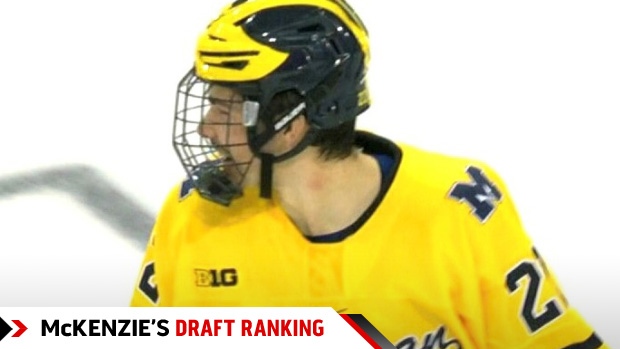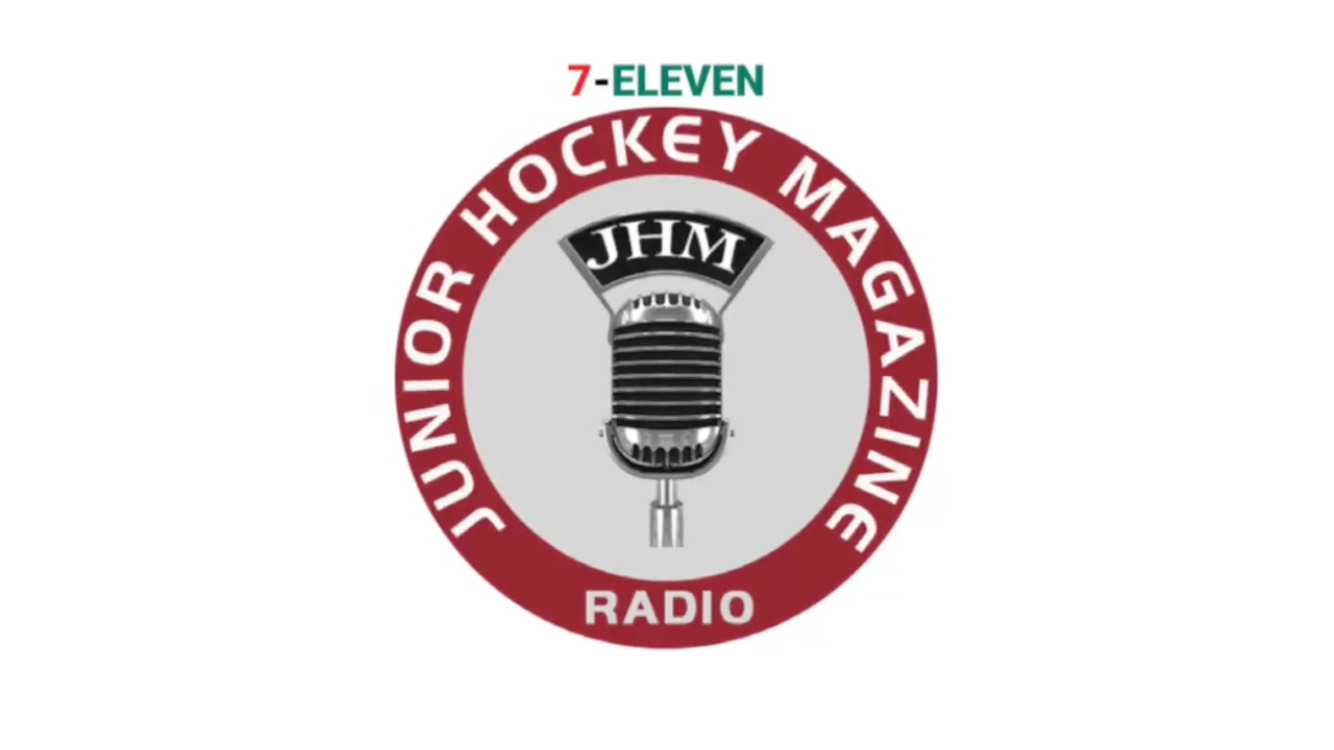Dec 15, 2020
Power leads first ranking of 2021 draft prospects compiled by TSN Hockey Insider Bob McKenzie

Let’s call it a Power Ranking. For now, anyway.
As in 6-foot-6 University of Michigan freshman defenceman Owen Power being the No. 1 prospect on TSN’s Top 20 Pre-Season 2021 NHL Draft Rankings.
More on that in a moment. Suffice to say, there’s a lot to unpack here.
Let’s start with the whole “pre-season” thing. It’s mid-December, right? Traditionally, our “pre-season” rankings come out no later than mid-September. Which is to say 2020 can’t end soon enough.
It would have been tough to do a “pre-season” ranking when the 2020 Stanley Cup playoffs were still going on in mid-September. So now, with the 2021 NHL regular season tentatively scheduled to start in mid-January, we can at least satisfy the “pre-season” tag.
But that brings with it another set of pandemic-produced problems.
It’s safe to say these 2021 pre-season draft rankings are the most convoluted and bizarro we’ve ever presented.
To wit: Some of the top prospects, especially those in the Western and Ontario Leagues, haven’t played a game since last March and who knows for sure when they will play again; some prospects, though, most notably the Swedes, Finns and Russians, have been playing for months; some of those Swedes have taken full advantage of that opportunity and rocketed up the draft charts, such as they are; one of those Finns, on the other hand, has seen his early-season stock plummet.
There’s never been a more uneven playing field right out of the gate than what the 2021 class is experiencing. To say TSN’s first ranking for 2021 is a mixed bag of who knows what is being kind.
And quite aside from the havoc created by the pandemic, the 2021 NHL draft was quite likely going to be a wide-open affair anyway.
Maybe things would be much clearer if hockey didn’t come to a screeching halt last spring. Perhaps if the Ivan Hlinka U-18 tourney had been played in August, like normal, the scouts’ views of the prospects would be more crystallized than they are now.
But the strong suspicion is even in “normal” times, the race for No. 1 in 2021 was going to be a hotly-contested competition.
And so here we are, starting with the premise of a Power Ranking,
For all the reasons listed above, it’s soon to declare 2021 the Owen Power Draft. Connor McDavid, Auston Matthews, John Tavares, Steven Stamkos — they got their names on their draft year from the get-go.
Now, it may well turn out to be the Owen Power Draft. We shall see. Six-foot-six defencemen who possess pretty much every tool scouts look for in a top-paring NHL blueliner – size, strength, mobility, passing and shooting, defending and physical play – are at a premium in any year.
Based on TSN’s survey of 10 NHL head scouts, and relative to the rest of this year’s field, Power is, at this moment, the clear and logical top prospect.
Four of our 10 scouts have Power at No. 1. Perhaps more telling, though, is that none of our 10 scouts ranked him any lower than fourth overall.
So while three other players — Swedish defenceman Simon Edvinsson; Edmonton Oil Kings forward Dylan Guenther; and Finnish centre Aatu Raty — each got two votes as the top prospect, those players’ other rankings were more all over the map, including some rankings outside of the Top 10.
Still, four prospects getting No. 1 consideration in the pre-season rankings is, as near as we can tell, is unprecedented. As is some of the top picks playing and some of them not playing.
Power, the Mississauga, Ont., native, is likely going to draw comparisons to other potential first-overall defencemen with similar physical stature. Such as towering Swedish blueliner Victor Hedman, who went No. 2 behind John Tavares in 2009.
Stylistically, it’s an apt comparison. To a point, that is.
“He’s not Hedman, not really, because Victor, at the same age, was elite in every category,” one NHL scout said. “Power is very good in every category, not elite. Could he use his size more effectively to be more physical? Sure. Could he produce more offensively? Sure. But when you look at the collection of tools he has, when you look at his offensive game, defensive game, the mobility, reading the play and how his overall game is tracking, you’re looking at a top-pairing, if not No. 1, NHL defenceman.”
Here’s a look at the rest of TSN’s Top 10 to start 2021:
2. Simon Edvinsson: The 6-foot-4 Swedish blueliner has the size, mobility, puck-moving and offensive upside to project as a potential top-pair NHL defenceman. Two of our 10 scouts pegged him at No. 1, but four scouts ranked Edvinsson outside the Top 10. It’s that kind of year.
3. Dylan Guenther: The 6-foot Edmonton Oil King scored 29 goals as a WHL rookie last season and earned a reputation as a versatile goal-scoring/playmaking forward. Two of our 10 scouts ranked him No. 1 and two more had him at No. 2, but not playing full time yet this season in the WHL may, anecdotally speaking, start chipping away at his status. He did play a handful of games in the Alberta Junior League for Sherwood Park. His projection is as a top-six NHL forward.
4. Matthew Beniers: The University of Michigan freshman centre didn’t get a vote for first overall but he did get three rankings at No. 2 and/or 3. Because he’s playing such a strong two-way game for the Wolverines, his star is most definitely ascending. He’s pegged to play between Matthew Boldy and Cole Caufield on the U.S. national junior team at the World Junior Championship, which will be a terrific opportunity for him to enhance his standing. Scouts are currently projecting him as an NHL second-line centre.
5. Brandt Clarke: The Barrie Colts’ defenceman has not played since last March but, and this is a testament to how much NHL scouts like his game, seven of 10 ranked him as high as No. 3 and no lower than No. 7. Clarke’s hockey sense is said to be elite and he’s highly effective at both ends of the ice. The consensus seems to be that even though he hasn’t been playing, Clarke warrants serious consideration in the same universe as Power and Edvinsson as the top defenceman in the draft.
6. William Eklund: The skilled and pace-pushing sub-6 foot Swedish winger has taken full advantage of 2021’s uneven playing field by lighting it up versus the men of the Swedish elite league. He has seven goals and 13 points in 17 games. Eklund would have been on the Swedish national junior team at the WJC but he tested positive for COVID-19 and had to be dropped, though he almost immediately resurfaced in the SHL. Again, 2020. Go figure. Six weeks ago, there was little chance Eklund would be ranked this high, but he’s made the most of his opportunity and scouts have taken notice in a big way.
7. Kent Johnson: The third Michigan Wolverine in our Top 10, Johnson is a highly skilled offensive forward who can be something of a human highlight reel. Three of our scouts ranked him in the top five and seven of 10 have him solidly in the Top 10. His game is flashier than Beniers but less well-rounded.
8. Aatu Raty: If Edvinsson and Eklund have benefitted from being able to play games while others can’t, Finnish centre Raty has effectively been penalized for playing. Or more precisely, not playing as well as expected. Raty still collected two No. 1 overall votes from our panel of scouts but even those who believe he still has a chance to contend for the top spot admit his game has been disappointing. He didn’t even get invited to Finland’s national junior team selection camp, even though he played in last year’s WJC as a 17-year-old. Those who like him believe Raty could project as a No. 2 NHL centre, but even before his disappointing start to this season, some scouts saw him more as a limited upside No. 3 NHL centre.
9. Mason McTavish: The Peterborough Pete 6-foot, 198-pound forward is a shoot-first goal-scorer who potted 29 in 57 OHL games last season. He garnered a pair of votes in the top three overall, but six of our 10 scouts had him just outside the Top 10. Which is to say there appears to be wide divergence of opinion on McTavish.
10. Luke Hughes: The third member of the USA Hockey Hughes clan — brothers Jack and Quinn, of course — is pretty much guaranteed to follow in their footsteps as an NHL first-rounder, but will Luke go in the Top 10 like Jack (No. 1) and Quinn (No. 7)? There’s certainly a chance. Luke has been measured at 6-foot-2, so that would make him the biggest of the three Hughes boys. And while he’s clearly an offense-first defenceman, no one is suggesting he’s as dynamic as Quinn. But there is considerable offensive upside there.
A few notes from our rankings between Nos. 11 and 20:
— Chaz Lucius at No. 11 is a distinct threat to displace someone in the Top 10. The U.S. U-18 forward is a dynamic scorer who led the U.S. U-17 program in goals last year. He hasn’t played this season but that’s not pandemic related. He reportedly is back skating now but has been hampered by a lingering knee issue that scouts want to see resolved. A month ago, Lucius would have unquestionably been in the Top 10 and may yet find himself there once he’s healthy and playing again.
— Swedish goalie Jesper Wallstedt, at No. 14, did get one vote in the top five overall. He’s one of three goalies on the Swedish national junior team at the WJC.
— Swedish winger Oskar Olausson, ranked at No. 16, has taken advantage of a strong start to rocket up the list. Like his countryman Eklund, Olausson appears a threat to be a Top 10 contender. He started this season as a B prospect on the NHL Central Scouting Bureau’s Players to Watch list.
— Only four of TSN’s Top 20 will be playing at the WJC in Edmonton — Beniers on Team USA; Russian defenceman Daniil Chayka (13); Swedish goalie Wallstedt (14) and forward Olausson (16).
Check out the full Top 20 list below (for stats and more info go to TSN.ca).
1. Owen Power
2. Simon Edvinsson
3. Dylan Guenther
4. Matthew Beniers
5. Brandt Clarke
6. William Eklund
7. Kent Johnson
8. Aatu Raty
9. Mason McTavish
10. Luke Hughes
11. Chaz Lucius
12. Fabian Lysell
13. Daniil Chayka
14. Jesper Wallstedt15. Zach Bolduc
16. Oskar Olausson
17. Carson Lambos
18. Zach L’Heureux
19. Brennan Othmann20. Cole Sillinger


